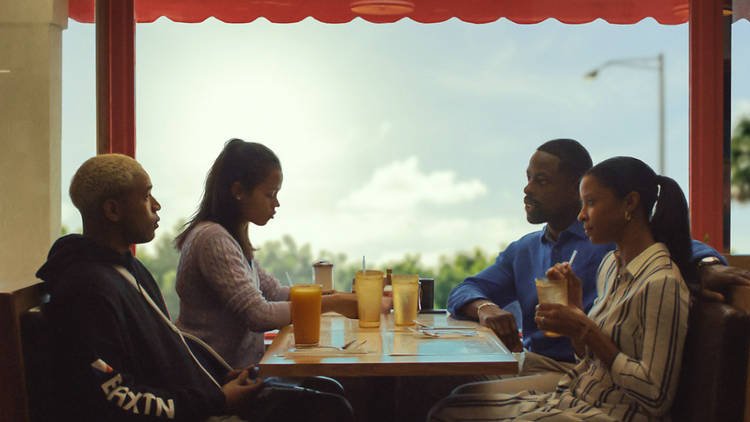Don’t expect to watch “Waves” like a movie. That’s what it is, technically, but it is precisely “Waves’” technical elements that elevate it beyond all cinematic convention — it is a roller coaster of sensory features that tears you along in a highly physical way. Trey Edward Shults’ latest film illustrates the arc of the Williams, a suburban African American family. The movie is divided into two distinct halves: first it focuses on Tyler (Kelvin Harrison Jr.), a high school wrestler whose tense relationship with his father Ronald (Sterling K. Brown) underscores a mental and physical battle with ideals of masculinity and leaves Tyler struggling to connect, especially with his girlfriend, Alexis (Alexa Demie). It then moves to Emily (Taylor Russell), Tyler’s sister, through whose eyes we experience the family’s reaction to the effects of a shocking tragedy. It’s a family drama on steroids that moves at a riveting pace as sound design, music, cinematography and color palette become characters as integral to shaping the film as the narrative itself.
“Waves” feels closer to an art installation than a film and is best described as a 360-degree, surround sound and 4-D experience. The incessant spinning is dizzying and initially feels reckless, though the camera asserts itself as a tangible extension of internal emotions: the rush of love, the fearlessness of youth, the ferocity of loss and the brutality of regret are all amplified by the intensity of coming-of-age firsts. We feel everything alongside the characters due to the visceral nature of what is truly an aural and visual odyssey.
The camera launches right into Tyler’s story in medias res; the ambulatory camera breeds a thrill of adrenaline as it spins within a car, from the car to the circling mats of a wrestling practice and from practice back to the Williams home, whose circular foyer and spiraling staircase continue the traveling cycle of motion. Shults secures full control of our sonic perception — he not only directed the film but did its music editing — by grounding our sense of the characters’ places within their environments. Shults smartly incorporates the technological minutiae of the everyday into the sound design: a series of text message notifications provides a metronomic background to the score and a chorus of sirens blends with the tension of electronic drones.
A focus on the music of everyday machines supplements a metaphor for the pressure Tyler faces to transform his body into a superhuman physique. The screaming mantra of his wrestling team, “I cannot be taken down, I am a new machine,” is the aggressive and terrifying accompaniment to a self-destructive mission through which Tyler’s physical limits threaten to break him mentally and spiritually.
Sound creates a sense of imminent danger that is magnified by colored lighting and a kaleidoscope of changing tones. During party scenes, the screen practically radiates with heat as the glow of deep orange, pink, purple and especially red and blue wash the compositions. The result is a watercolored, kaleidoscopic style of representation that at first mesmerizes its viewers, but quickly devolves into repetitive, overdone eye candy.
Keeping up with the plot is a taxing emotional marathon — without giving too much away, imagine everything that could go wrong going worse. The stacking of tragedy upon tragedy threatens to push the story into a realm of outright melodrama, especially in Emily’s half. The actors are totally immersed in their roles; it’s hard not to empathize with Emily’s step-mom, Catharine (Renée Elise Goldsbury) when grief takes a physical toll on her, and of course with Emily, who seems to carry the burdens of her entire family with a maturity beyond her years. Her boyfriend, Luke (Lucas Hedges), is “Waves’” refreshing comic relief, his boyish charm and cutesy innocence providing much-needed respite from the heavy drama.
A lot of things could have gone wrong in the making of this film. It’s not often a white director makes a film about black Americans and gets it right. Shults’s success can all be credited to the deeply collaborative effort between Shults and actor Kelvin Harrison Jr. The two met when they collaborated on 2017’s “It Comes At Night” and discussed working together on a future movie revolving around high school students — the result was “Waves.” In writing and shooting the film, Shults explains how he conducted extensive interviews with Harrison and the other cast members to formulate characters based in a sense of honesty. Shults worked to establish a realistic personal history for Tyler based on Harrison’s experiences, discussing motivations in each of his scenes and the symbolism of his surroundings, right down to the color of Tyler’s truck.
This depth is admirable, demonstrating a true love of subject and storytelling, but it is also overwhelming: trying to focus on a mountain of details while absorbing every camera move, every trick of light, and every novel sound pushes the film to the very edge of a spectacle of sensory overload.
A version of this article appears in the Monday, Nov. 18, 2019, print edition. Email Alexandra Bentzien at [email protected].


























































































































































